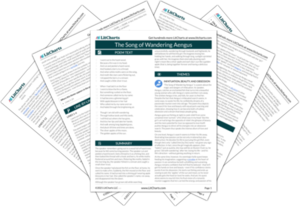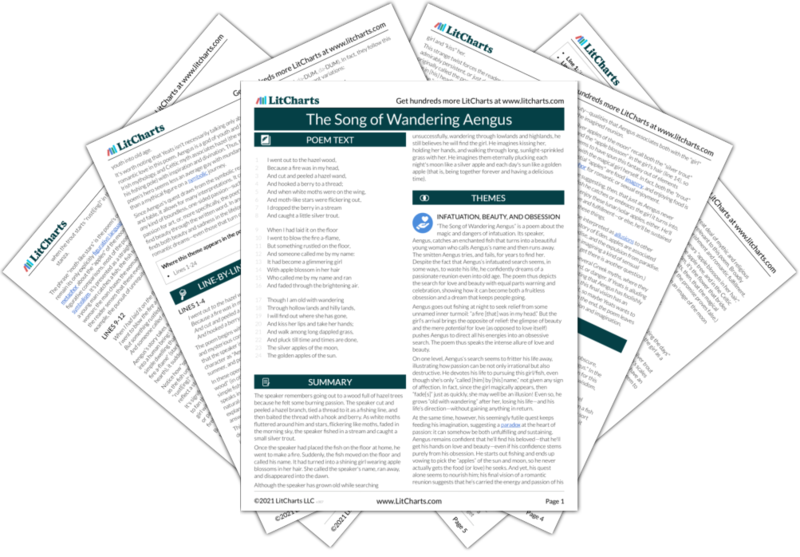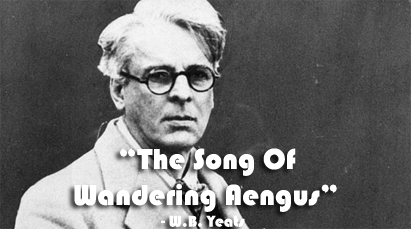

The Song of Wandering Aengus Summary & Analysis by William Butler Yeats
- Line-by-Line Explanation & Analysis
- Poetic Devices
- Vocabulary & References
- Form, Meter, & Rhyme Scheme
- Line-by-Line Explanations

First printed in 1897 and collected in The Wind Among the Reeds (1899), W. B. Yeats's "The Song of Wandering Aengus" is a dramatic monologue about burning and thwarted passion. Written in the voice of Aengus (a god of love and youth in Irish mythology), it tells the tale of a magical fish that turns into a beautiful girl and runs away. The infatuated Aengus wanders the earth in pursuit of this girl, growing old but never giving up his search. As a kind of miniature fable, the poem suggests how unrequited love—or any other unattainable dream—can both exhaust a person's energies and nourish a person's imagination.
- Read the full text of “The Song of Wandering Aengus”

The Full Text of “The Song of Wandering Aengus”
1 I went out to the hazel wood,
2 Because a fire was in my head,
3 And cut and peeled a hazel wand,
4 And hooked a berry to a thread;
5 And when white moths were on the wing,
6 And moth-like stars were flickering out,
7 I dropped the berry in a stream
8 And caught a little silver trout.
9 When I had laid it on the floor
10 I went to blow the fire a-flame,
11 But something rustled on the floor,
12 And someone called me by my name:
13 It had become a glimmering girl
14 With apple blossom in her hair
15 Who called me by my name and ran
16 And faded through the brightening air.
17 Though I am old with wandering
18 Through hollow lands and hilly lands,
19 I will find out where she has gone,
20 And kiss her lips and take her hands;
21 And walk among long dappled grass,
22 And pluck till time and times are done,
23 The silver apples of the moon,
24 The golden apples of the sun.
“The Song of Wandering Aengus” Summary
“the song of wandering aengus” themes.

Infatuation, Beauty, and Obsession
- See where this theme is active in the poem.
Line-by-Line Explanation & Analysis of “The Song of Wandering Aengus”
I went out to the hazel wood, Because a fire was in my head, And cut and peeled a hazel wand, And hooked a berry to a thread;

And when white moths were on the wing, And moth-like stars were flickering out, I dropped the berry in a stream And caught a little silver trout.
When I had laid it on the floor I went to blow the fire a-flame, But something rustled on the floor, And someone called me by my name:
Lines 13-16
It had become a glimmering girl With apple blossom in her hair Who called me by my name and ran And faded through the brightening air.
Lines 17-20
Though I am old with wandering Through hollow lands and hilly lands, I will find out where she has gone, And kiss her lips and take her hands;
Lines 21-24
And walk among long dappled grass, And pluck till time and times are done, The silver apples of the moon, The golden apples of the sun.
“The Song of Wandering Aengus” Symbols

- See where this symbol appears in the poem.

Silver Trout

“The Song of Wandering Aengus” Poetic Devices & Figurative Language
- See where this poetic device appears in the poem.
Parallelism
Alliteration, juxtaposition, “the song of wandering aengus” vocabulary.
Select any word below to get its definition in the context of the poem. The words are listed in the order in which they appear in the poem.
- On the wing
- Apple blossom
- See where this vocabulary word appears in the poem.

Form, Meter, & Rhyme Scheme of “The Song of Wandering Aengus”
Rhyme scheme, “the song of wandering aengus” speaker, “the song of wandering aengus” setting, literary and historical context of “the song of wandering aengus”, more “the song of wandering aengus” resources, external resources.
The Poet's Life and Work — Read a short bio of Yeats, along with other Yeats poems, at Poets.org.
The Poem Read Aloud — Hear a reading of the poem by actor Michael Gambon.
"Aengus" in Song — Listen to a 1971 adaptation of the poem by folk singer Donovan.
Yeats, Nobel Laureate — Browse an exhibit on Yeats, winner of the 1923 Nobel Prize in Literature, at Nobel.org.
The Many Sides of Yeats — Read the Poetry Foundation's introduction to the various phases of Yeats's career.
Yeats Reads His Work — Listen to a rare recording of W. B. Yeats reading his poetry aloud.
LitCharts on Other Poems by William Butler Yeats
Adam's Curse
Among School Children
An Irish Airman Foresees his Death
A Prayer for my Daughter
Easter, 1916
In Memory of Eva Gore-Booth and Con Markievicz
Lapis Lazuli
Leda and the Swan
Sailing to Byzantium
September 1913
The Lake Isle of Innisfree
The Second Coming
The Wild Swans at Coole
When You Are Old
Ask LitCharts AI: The answer to your questions

The Song of Wandering Aengus
By william butler yeats, the song of wandering aengus study guide.
" The Song of Wandering Aengus " is a poem by the Irish writer W.B. Yeats, first published in 1897 before appearing in Yeats's 1899 collection The Wind Among the Reeds. The poem describes Aengus—an Irish god of youth, poetry, and love—entering the woods, where he fishes a trout out of a stream. The trout suddenly transforms into a girl, who promptly disappears. Aengus then spends his life seeking her out, becoming old in the process, though he never loses faith in his eventual success.
The work responds to the mythology surrounding the figure of Aengus, who, in Irish lore, spends years seeking out a woman who appears to him in a dream. In this way, the poem fits into the segment of Yeats's oeuvre concerned with Irish myth and legend, as well as his broader interest in the mystical and supernatural. The poem is also a product of the Irish Literary Revival, taking as its subject Celtic culture.
The poem consists of three octaves written in iambic tetrameter. It follows a songlike ABCBDEFE rhyme scheme. In its story of the woman's transformation and Aengus's subsequent search, it highlights themes of love, aging, nature, and indeed transformation and change itself.

The Song of Wandering Aengus Questions and Answers
The Question and Answer section for The Song of Wandering Aengus is a great resource to ask questions, find answers, and discuss the novel.
Study Guide for The Song of Wandering Aengus
The Song of Wandering Aengus study guide contains a biography of William Butler Yeats, literature essays, quiz questions, major themes, characters, and a full summary and analysis.
- About The Song of Wandering Aengus
- The Song of Wandering Aengus Summary
- Character List
- Lesson Plans
- Teacher's Guides
- Media Resources
“The Song of Wandering Aengus” by W. B. Yeats

Loch Gill seen from nature trail running through Hazelwood Country Park, on the outskirts of Sligo, Ireland, and immortalized by W. B. Yeats in “The Song of Wandering Aengus.”
Wikimedia Commons
"I think a kind of half ballad, half lyric ... is the kind of poem I like best myself—a ballad that gradually lifts ... from circumstantial to purely lyrical writing. ... I only learnt that slowly and used to be content to tell stories . ... One must always have lyric emotion or some revelation of beauty…" —Letter from W.B. Yeats to Dora Sigerson (1899)
Teacher guide “The Song of Wandering Aengus” by W. B. Yeats includes information about the poem and discussion questions. Supplementary documents provide contextual background on Irish traditional sources including Celtic mythology and Irish aisling poetry.
On this Page:
About the Poem
Questions for discussion, questions for further discussion.
“The Song of Wandering Aengus”
I went out to the hazel wood, Because a fire was in my head, And cut and peeled a hazel wand, And hooked a berry to a thread; And when white moths were on the wing, And moth-like stars were flickering out, I dropped the berry in a stream And caught a little silver trout.
When I had laid it on the floor I went to blow the fire a-flame, But something rustled on the floor, And someone called me by my name: It had become a glimmering girl With apple blossom in her hair Who called me by my name and ran And faded through the brightening air.
Though I am old with wandering Through hollow lands and hilly lands, I will find out where she has gone, And kiss her lips and take her hands; And walk among long dappled grass, And pluck till time and times are done, The silver apples of the moon, The golden apples of the sun.
The Wind Among the Reeds, 1899. 4th ed. (London, 1903), 15–16. Available at Project Gutenberg .
An online version of the poem is also available on EDSITEment-reviewed Academy of American Poets.
William Butler Yeats wrote “The Song of Wandering Aengus” on January 31 sometime in the late 1890s. It was first printed in 1897 under the title "A Mad Song." The current title "The Song of Wandering Aengus" was applied when it was finally published in The Wind Among the Reeds (1899). These early collected poems displayed Yeats's mastery of the lyric form as well as his passion for Celtic mythology and Irish folklore, which were to fuel his poetic genius throughout his career.
“The Song of Wandering Aengus” is deceptively simple, yet it paints a haunting story containing many mythological allusions and nuanced levels of meaning. The speaker is an old man reminiscing about an event long ago when he was compelled to go out to cut a branch for fishing. With it, he caught a magical silver trout, which was then transformed into a vision of a “glimmering” maiden. The life-quest he set himself was to find this girl who called his name before she vanished.
In the poem, Yeats contrasts two realities: the earthly realm of ordinary life and the mystical otherworld of dreams. He wrestles with conflicting desires—the ongoing need to handle the practical things of life and the strong compulsion to follow one’s dreams. To express this conflict, Yeats employs a break in the middle of each stanza signaled by a semicolon or colon. This shift underlines the gap between the earthly, physical world and the mysterious, magical otherworld. It moves the reader from the concrete world of the particular to the abstract world of the universal.
For background on the life and work of the poet, see the EDSITEment-reviewed Poetry Foundation entry on “ W. B. Yeats ” and Stephen Watt's, “The Voice of Nationalism: One Hundred Years of Irish Theatre,” Humanities 20, no.1 (1999).
The seven questions in this worksheet can be adapted for use in a classroom discussion or literature circle and are aligned with Common Core literacy standards for grade 8. In whatever venue, make sure that students provide evidence from the poem in their answers. (See also the teacher version with suggested answers. )
- Question 5 discusses the terms below and their meanings from the EDSITEment literary glossary: assonance ; repetition ; alliteration ; consonance ; and meter .
- Question 7 references another poem about dreams also published in The Wind Among the Reeds , “ Aedh Wishes for the Cloths of Heaven .”
Five questions for further discussion are found in the accompanying worksheet . However, before delving deeper into the poem, you will need to read and discuss the information included in Traditional Irish Sources for “The Song of Wandering Aengus” with students. After reading this contextual background, the questions can be raised for discussion and/or used as a basis for writing activities. (See the teacher version with suggested answers ).
Note: Question 5 references the late 20th-century aisling by Seamus Heaney, " A Hazel Stick for Catherine Ann ,” in Opened Ground: Selected Poems, 1966–1996 (New York: Farrar, Straus and Giroux, 1998), 214.
Materials & Media
Wandering aengus: worksheet 1. questions for discussion, wandering aengus: worksheet 2. questions for further discussion, wandering aengus: traditional irish sources for “the song of wandering aengus”, wandering aengus: questions for discussion (teacher version), wandering aengus: questions for further discussion (teacher version), related on edsitement, twenty-one poems for ap literature and composition, twenty-one more poems for ap english, charles baudelaire: poète maudit (the cursed poet), chinua achebe’s things fall apart.
Have an account?

The Song of Wandering Aengus
3 questions

Introducing new Paper mode
No student devices needed. Know more
Which word best describes the story told in the poem?
hallucination
Which event was most surprising to Aengus?
He sleepwalked into the forest.
Moths were all around him.
The fish he caught became a girl.
He found silver and golden apples.
In the line I went out to the hazel wood, the sound device used is called-
alliteration
Explore all questions with a free account

Continue with email
Continue with phone

The Song Of Wandering Aengus | Questions And Answers

Vocabulary & Translation in Nepali Of 'THE SONG OF WANDERING AENGUS'
Critical Appreciation Of 'THE SONG OF WANDERING AENGUS'
Question - Answers Of 'THE SONG OF WANDERING AENGUS':

IMAGES
VIDEO
COMMENTS
The Song of Wandering Aengus Related Poem Content Details BY WILLIAM BUTLER YEATS I went out to the hazel wood, Because a fire was in my head, And cut and peeled a hazel wand, And hooked a berry to a thread; And when white moths were on the wing, And moth-like stars were flickering out, I dropped the berry in a stream And caught a little silver trout. When I had laid it on the floor I went to ...
The Full Text of "The Song of Wandering Aengus". 1 I went out to the hazel wood, 2 Because a fire was in my head, 3 And cut and peeled a hazel wand, 4 And hooked a berry to a thread; 5 And when white moths were on the wing, 6 And moth-like stars were flickering out, 7 I dropped the berry in a stream.
The Song of Wandering Aengus - Comprehension Questions Answer Key 1. Where does the speaker of the poem go? A. to the moon B. to a hazel wood C. to the sun D. to the bottom of a stream 2. What does the second stanza of the poem describe? A. a glimmering girl B. an old wanderer C. a trout in a stream D. a white moth in flight 3.
1 pt. The speaker is not feeling well at the beginning of the poem. What evidence from the poem helps you make this inference? "I dropped the berry in a stream". "A fire was in my head". "I went out to the hazel wood". "I went to blow the fire a-flame". 3. Multiple Choice.
The Song of Wandering Aengus. 'The Song of Wandering Aengus' is a compelling Yeats poem that delves into Aengus' relentless search for a mystical girl he encountered in his youth. William Butler Yeats was one of the most important poets of the 20th century. He passed away in January 1939 after a career in , , and poetry.
By William Butler Yeats. I went out to the hazel wood, Because a fire was in my head, And cut and peeled a hazel wand, And hooked a berry to a thread; And when white moths were on the wing, And moth-like stars were flickering out, I dropped the berry in a stream. And caught a little silver trout.
The Song of Wandering Aengus Study Guide. "The Song of Wandering Aengus" is a poem by the Irish writer W.B. Yeats, first published in 1897 before appearing in Yeats's 1899 collection The Wind Among the Reeds. The poem describes Aengus—an Irish god of youth, poetry, and love—entering the woods, where he fishes a trout out of a stream.
The Ballad Form. "The Song of Wandering Aengus" follows the form of the ballad, a traditional structure found in both folk music and poetry. The quintessential ballad tells a story, often of ...
"The Song of Wandering Aengus" is a poem by Irish poet W. B. Yeats.It was first printed in 1897 in British magazine The Sketch under the title "A Mad Song." It was then published under its standard name in Yeats' 1899 anthology The Wind Among the Reeds. It is especially remembered for its two final lines: "The silver apples of the moon,/ The golden apples of the sun."
About the Poem. William Butler Yeats wrote "The Song of Wandering Aengus" on January 31 sometime in the late 1890s. It was first printed in 1897 under the title "A Mad Song." The current title "The Song of Wandering Aengus" was applied when it was finally published in The Wind Among the Reeds (1899). These early collected poems displayed ...
This video is from the award winning StudySync® english language arts program for grades 6-12. Learn more at: http://www.mheonline.com/studysync
William Butler (W. B.) Yeats. William Butler Yeats's "The Song of Wandering Aengus" is a poem that draws on, and repurposes, the folklore of Yeats's native Ireland. In Celtic mythology, Aengus is the eternally youthful god of love who falls for Caer the goddess of sleep and dreams. In the myth, Aengus gets the girl and lives on in ...
Get an answer for 'What are the main themes of "The Song of Wandering Aengus" by W. B. Yeats?' and find homework help for other The Song of Wandering Aengus questions at eNotes
The Song of Wandering Aengus Lyrics. I went out to the hazel wood, Because a fire was in my head, And cut and peeled a hazel wand, And hooked a berry to a thread; And when white moths were on the ...
Summary. PDF Cite. "The Song of Wandering Aengus" first appeared in 1899 in William Butler Yeats's third verse collection, The Wind and the Reeds. Like many of Yeats's early works, the ...
1. Multiple Choice. 30 seconds. 1 pt. In "The Song of Wandering Aengus," the poet uses the phrase a fire was in my head in line 2 to suggest that the narrator —. was excited to go fishing in the stream. had planned to catch dinner and cook it. had many ideas burning in his brain. was searching for a fire in the woods.
Yeats's "Song of Wandering Aengus" expresses the Romantic longing for eternity. The Celtic Otherworld, where Aengus the god resides, is a world of eternal forms where time does not flow.
1 pt. Which event was most surprising to Aengus? He sleepwalked into the forest. Moths were all around him. The fish he caught became a girl. He found silver and golden apples. 3. Multiple Choice.
Aengus's story in "The Song of Wandering Aengus" can be read as a twist on the myth of Connla. The glimmering girl wears an "apple blossom" in her hair that symbolizes her eternally ...
1 pt. The speaker is not feeling well at the beginning of the poem. What evidence from the poem helps you make this inference? "I dropped the berry in a stream". "A fire was in my head". "I went out to the hazel wood". "I went to blow the fire a-flame". 3. Multiple Choice.
Questions and Answers for " THE SONG OF WANDERING AENGUS", written by 'W.B. Yeats'. W.B. Yeats was an Irish dramatist and poet. He lived very passionate life. The feelings and experiences of his passionate life were transferred into his poetry. His love were with Maud Gonne became the chief subject of his poetry.
The Wooing of Maud Gonne. In 1889, Yeats met a young woman named Maud Gonne, an acquaintance of his father's. Gonne, who was tall, outgoing, and politically engaged—in many ways the opposite ...